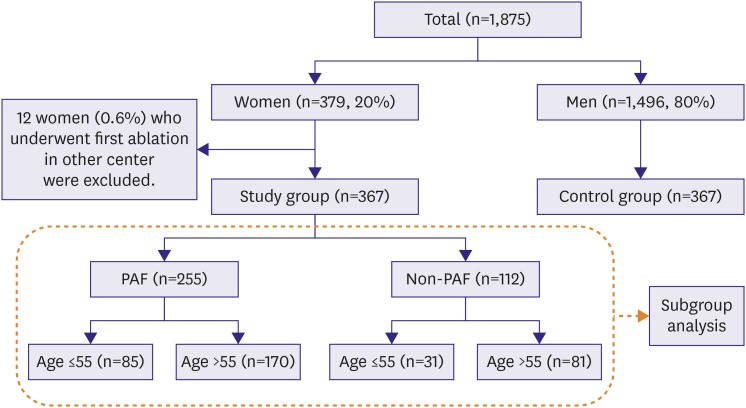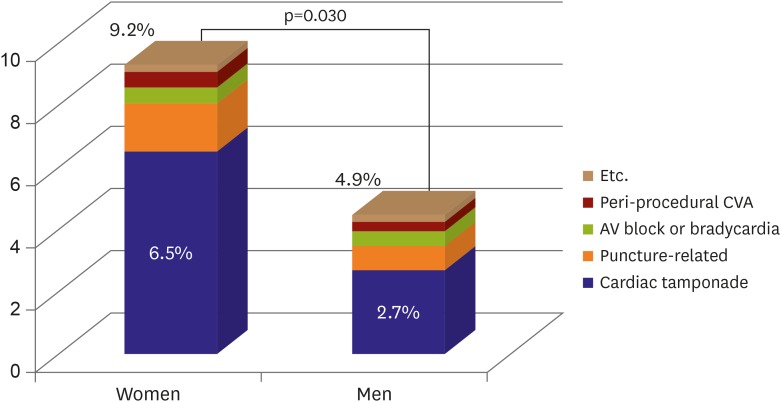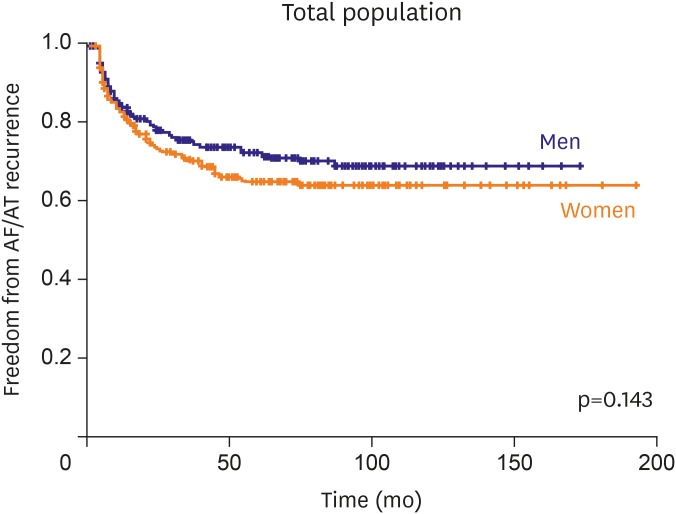Korean Circ J.
2018 Jul;48(7):605-618. 10.4070/kcj.2017.0327.
Gender-related Difference in Clinical Outcome of the Patient with Atrial Fibrillation after Radiofrequency Catheter Ablation
- Affiliations
-
- 1Division of Cardiology, Dongguk University College of Medicine and Dongguk University Medical Center, Goyang, Korea.
- 2Division of Cardiology, Korea University College of Medicine and Korea University Anam Hospital, Seoul, Korea. yhkmd@unitel.co.kr
- 3Division of Cardiology, Pusan National University Hospital, Busan, Korea.
- 4Division of Cardiology, Sejong General Hospital, Bucheon, Korea.
- 5Division of Cardiology, Chungbuk National University Hospital, Cheongju, Korea.
- KMID: 2414895
- DOI: http://doi.org/10.4070/kcj.2017.0327
Abstract
- BACKGROUND AND OBJECTIVES
Previous studies provided controversial result about gender differences in the clinical outcome after radiofrequency catheter ablation (RFCA) for atrial fibrillation (AF). We assessed pure difference after adjustment of referral bias.
METHODS
The clinical outcomes including freedom from AF/atrial tachycardia (AT) recurrence after RFCA were compared between women and men in 1:1 confounding factor matching with age, AF type, periods since diagnosis (±12 months), and procedure era (±12 months). Subgroup analysis was performed in categories defined by AF type and age of 55 (mean menopausal age of Asian women).
RESULTS
Total 1,875 patients with AF underwent 2,307 RFCA between January 1998 and May 2014 in a single center. Total 367 women (19.6%, 59±10 years) who had undergone first ablation were included. Women had larger left atrial diameter index (26±4 vs. 23±4 mm/m2; p < 0.001) and higher peri-procedural complications (9.2% vs. 4.9%; p=0.030) compared to men. The freedom from AF/AT recurrence after RFCA was not different between both groups (71% vs. 76%; log-rank p=0.131, mean follow-up of 55 months). Women with non-paroxysmal AF (PAF) had significantly worse outcome (54% vs. 69%; p=0.014), especially in subgroup with age ≤55 (48% vs. 71%; p=0.010). In multivariate analysis, female gender was an independent predictor of recurrence in subgroup with non-PAF and age ≤55 (hazard ratio [HR], 2.539; 95% confidence interval [CI], 1.112-5.801; p=0.027).
CONCLUSIONS
The clinical outcome after RFCA was not different between both genders regardless of referral bias. However, the gender difference became evident in patients under 55 years with non-PAF.
Keyword
MeSH Terms
Figure
Cited by 1 articles
-
Gender Difference in Catheter Ablation: Atrial Fibrillations from Mars and Venus?
Hee Tae Yu, Hui-Nam Pak
Korean Circ J. 2018;48(7):619-621. doi: 10.4070/kcj.2018.0094.
Reference
-
1. Chugh SS, Havmoeller R, Narayanan K, et al. Worldwide epidemiology of atrial fibrillation: a Global Burden of Disease 2010 Study. Circulation. 2014; 129:837–847. PMID: 24345399.2. Piccini JP, Hammill BG, Sinner MF, et al. Incidence and prevalence of atrial fibrillation and associated mortality among Medicare beneficiaries, 1993–2007. Circ Cardiovasc Qual Outcomes. 2012; 5:85–93. PMID: 22235070.3. Potpara TS, Marinkovic JM, Polovina MM, et al. Gender-related differences in presentation, treatment and long-term outcome in patients with first-diagnosed atrial fibrillation and structurally normal heart: the Belgrade atrial fibrillation study. Int J Cardiol. 2012; 161:39–44. PMID: 21570138.4. Ong L, Irvine J, Nolan R, et al. Gender differences and quality of life in atrial fibrillation: the mediating role of depression. J Psychosom Res. 2006; 61:769–774. PMID: 17141664.5. Salam AM, AlBinali HA, Al-Mulla AW, et al. Women hospitalized with atrial fibrillation: gender differences, trends and outcome from a 20-year registry in a Middle Eastern country (1991–2010). Int J Cardiol. 2013; 168:975–980. PMID: 23159409.6. Wang TJ, Massaro JM, Levy D, et al. A risk score for predicting stroke or death in individuals with new-onset atrial fibrillation in the community: the Framingham Heart Study. JAMA. 2003; 290:1049–1056. PMID: 12941677.7. Fang MC, Singer DE, Chang Y, et al. Gender differences in the risk of ischemic stroke and peripheral embolism in atrial fibrillation: the AnTicoagulation and Risk factors In Atrial fibrillation (ATRIA) study. Circulation. 2005; 112:1687–1691. PMID: 16157766.8. Wolf PA, Mitchell JB, Baker CS, Kannel WB, D'Agostino RB. Impact of atrial fibrillation on mortality, stroke, and medical costs. Arch Intern Med. 1998; 158:229–234. PMID: 9472202.9. Friberg J, Scharling H, Gadsboll N, Truelsen T, Jensen GB, Copenhagen City Heart S. Comparison of the impact of atrial fibrillation on the risk of stroke and cardiovascular death in women versus men (The Copenhagen City Heart Study). Am J Cardiol. 2004; 94:889–894. PMID: 15464671.10. Humphries KH, Kerr CR, Connolly SJ, et al. New-onset atrial fibrillation: sex differences in presentation, treatment, and outcome. Circulation. 2001; 103:2365–2370. PMID: 11352885.11. Paquette M, Roy D, Talajic M, et al. Role of gender and personality on quality-of-life impairment in intermittent atrial fibrillation. Am J Cardiol. 2000; 86:764–768. PMID: 11018197.12. Balk EM, Garlitski AC, Alsheikh-Ali AA, Terasawa T, Chung M, Ip S. Predictors of atrial fibrillation recurrence after radiofrequency catheter ablation: a systematic review. J Cardiovasc Electrophysiol. 2010; 21:1208–1216. PMID: 20487117.13. Forleo GB, Tondo C, De Luca L, et al. Gender-related differences in catheter ablation of atrial fibrillation. Europace. 2007; 9:613–620. PMID: 17636302.14. Rienstra M, Van Veldhuisen DJ, Hagens VE, et al. Gender-related differences in rhythm control treatment in persistent atrial fibrillation: data of the Rate Control Versus Electrical Cardioversion (RACE) study. J Am Coll Cardiol. 2005; 46:1298–1306. PMID: 16198847.15. Patel D, Mohanty P, Di Biase L, et al. Outcomes and complications of catheter ablation for atrial fibrillation in females. Heart Rhythm. 2010; 7:167–172. PMID: 20022814.16. January CT, Wann LS, Alpert JS, et al. 2014 AHA/ACC/HRS guideline for the management of patients with atrial fibrillation: executive summary: a report of the American College of Cardiology/American Heart Association Task Force on practice guidelines and the Heart Rhythm Society. Circulation. 2014; 130:2071–2104. PMID: 24682348.17. Schoenaker DA, Jackson CA, Rowlands JV, Mishra GD. Socioeconomic position, lifestyle factors and age at natural menopause: a systematic review and meta-analyses of studies across six continents. Int J Epidemiol. 2014; 43:1542–1562. PMID: 24771324.18. Hart RG, Pearce LA, McBride R, Rothbart RM, Asinger RW. Factors associated with ischemic stroke during aspirin therapy in atrial fibrillation: analysis of 2012 participants in the SPAF I-III clinical trials. The Stroke Prevention in Atrial Fibrillation (SPAF) Investigators. Stroke. 1999; 30:1223–1229. PMID: 10356104.19. Benjamin EJ, Wolf PA, D'Agostino RB, Silbershatz H, Kannel WB, Levy D. Impact of atrial fibrillation on the risk of death: the Framingham Heart Study. Circulation. 1998; 98:946–952. PMID: 9737513.20. Santangeli P, di Biase L, Pelargonio G, Natale A. Outcome of invasive electrophysiological procedures and gender: are males and females the same? J Cardiovasc Electrophysiol. 2011; 22:605–612. PMID: 20958833.21. Michowitz Y, Rahkovich M, Oral H, et al. Effects of sex on the incidence of cardiac tamponade after catheter ablation of atrial fibrillation: results from a worldwide survey in 34 943 atrial fibrillation ablation procedures. Circ Arrhythm Electrophysiol. 2014; 7:274–280. PMID: 24519888.22. Shah RU, Freeman JV, Shilane D, Wang PJ, Go AS, Hlatky MA. Procedural complications, rehospitalizations, and repeat procedures after catheter ablation for atrial fibrillation. J Am Coll Cardiol. 2012; 59:143–149. PMID: 22222078.23. Dewland TA, Wintermark M, Vaysman A, et al. Use of computed tomography to identify atrial fibrillation associated differences in left atrial wall thickness and density. Pacing Clin Electrophysiol. 2013; 36:55–62. PMID: 23106219.24. Olivares-Reyes A, Chan S, Lazar EJ, Bandlamudi K, Narla V, Ong K. Atrial septal aneurysm: a new classification in two hundred five adults. J Am Soc Echocardiogr. 1997; 10:644–656. PMID: 9282354.25. Coutinho T, Borlaug BA, Pellikka PA, Turner ST, Kullo IJ. Sex differences in arterial stiffness and ventricular-arterial interactions. J Am Coll Cardiol. 2013; 61:96–103. PMID: 23122799.26. Perez MV, Wang PJ, Larson JC, et al. Effects of postmenopausal hormone therapy on incident atrial fibrillation: the Women's Health Initiative randomized controlled trials. Circ Arrhythm Electrophysiol. 2012; 5:1108–1116. PMID: 23169946.27. Saito T, Ciobotaru A, Bopassa JC, Toro L, Stefani E, Eghbali M. Estrogen contributes to gender differences in mouse ventricular repolarization. Circ Res. 2009; 105:343–352. PMID: 19608983.28. Zhang Y, Ouyang P, Post WS, et al. Sex-steroid hormones and electrocardiographic QT-interval duration: findings from the third National Health and Nutrition Examination Survey and the Multi-Ethnic Study of Atherosclerosis. Am J Epidemiol. 2011; 174:403–411. PMID: 21768401.29. Wyse DG, Waldo AL, DiMarco JP, et al. A comparison of rate control and rhythm control in patients with atrial fibrillation. N Engl J Med. 2002; 347:1825–1833. PMID: 12466506.30. Van Gelder IC, Hagens VE, Bosker HA, et al. A comparison of rate control and rhythm control in patients with recurrent persistent atrial fibrillation. N Engl J Med. 2002; 347:1834–1840. PMID: 12466507.
- Full Text Links
- Actions
-
Cited
- CITED
-
- Close
- Share
- Similar articles
-
- A Case of Chronic Radiodermatitis following Radiofrequency Catheter Ablation for Atrial Fibrillation
- A Case of Successful Ablation of Right-Sided Accessory Pathway during Atrial Fibrillation
- Radiofrequency Catheter Ablation of Persistent Atrial Fibrillation with Myotonic Dystrophy and Achalasia-like Esophageal Dilatation
- Cerebral Infarction After Radiofrequency Catheter Ablation in Patients With Paroxysmal Atrial Fibrillation
- Successful Management of Atrio-Esophageal Fistula after Cardiac Radiofrequency Catheter Ablation





